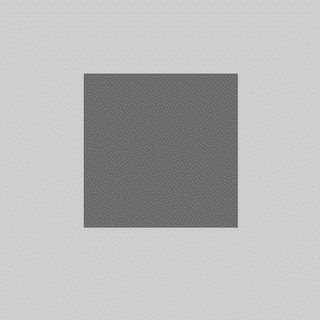You can see this processing system at work. Take a look at the inside and outside edges of the dark gray square. Around the outside of the dark shape, you can see a slight halo of lighter gray. Inside the dark square, you can see a slightly darker gray. That's not what's actually there—it's the lower levels of your optic nerve saying "I found an edge! I found an edge! It's right here!"

Photographers control edges through the manipulation of focus. The subject of the photo is generally in focus, with hard edges, while the rest of the photo may be blurred and out of focus. That mimics the way your eye works. At any given time, only the very center of your visual field is clear. In part that's because your eye, like a camera lens, can only focus at one distance at a time. But more importantly, only the very center part of your retina—the fovea—has a high density of visual receptor cells. Only foveal vision has any degree of detail; the rest is just a vague blur. You are generally not aware of how tiny your window of detailed vision is, because your brain hides that annoying detail from you. You naturally move your eye around whatever you are looking at, and your brain pieces together an internal conceptual image in which you have the illusion of seeing, at any given moment, a far larger region of detailed information than your eyes are actually delivering to you. In fact, you can't choose not to move your eyes around—even though you may be staring at one spot, there is a slight movement of your eye muscles.
The strongest signal of what is in focus, and what is within foveal vision, is the hard edge. Outside of the eye's focal point, and outside of foveal vision, all edges are blurred. Within that zone, any edges that have a strong value transition are emphasized and used by the visual system to develop a conceptual model of three-dimensional visual space.
Painters have the ability to control the sharpness of any edge they wish. An edge can be sharp, completely blurred, or somewhere in between. Over the course of it's length, you can make an edge change from hard to soft and back to hard again. You can also "lose" an edge by having it blend into it's background, present only by inference. The systematic use of hard, soft, and lost edges is a powerful tool for composition and control of the viewer's eye. Because the eye is attracted by hard edges, you can enhance the hardness of whatever you want the viewer to look at more. You can make visual pathways of hard edges that define how the eye enters and moves around the composition. You can suggest shape by making receding edges softer. You can create a sense of mystery and visual engagement by hiding some edges, requiring the viewer to participate in the process of creating the picture by creating edges where you haven't actually painted them.
Prior to the development of the Venetian style of painting in the early 16th century (Bellini, Giorgione, Titian), edges were usually painted hard, except where soft transitions were required to represent soft forms, forms in shadow, forms in the distance, or turning edges. The Venetian school painters (and all of the vast number of artist influenced by them, such as Rembrandt, Rubens, Velázquez, and just about everyone since then) developed ways to use edges as a compositional device. If you paint all edges except those around your focal point as soft, then the eye is naturally drawn to that area. If you paint objects that are closer to the viewer as having harder edges, then those objects appear closer and you effectively define the three-dimensional space of the picture. If you paint a variety of hard, soft, and lost edges, you increase the complexity of the painting and invite the viewer to explore the composition.
Someday, I'll be able to make all that work in my compositions without effort. In the meantime, it helps to understand the theory, study paintings that use edges effectively (such as those by Ingres), and become more conscious of how I use edges in composition.
No comments:
Post a Comment